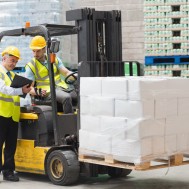As tax-time rolls around, many businesses will review operating budgets and generate corresponding forecasts. Are you looking for new ways to reduce overhead and further dive into the black? Are you looking for tips on how to slash material handling costs?
The good news is there are many initiatives you can take to achieve such a feat. Optimizing space, preventing damage, space management, technology investment and fluid communications are just a few of the many steps you can take to reduce material handling costs. Here are five proven and true ways to deduct unnecessary expenditures from that material handling operating budget.
1. Make the most of your space.
A general rule of thumb here is working with what you have. Optimizing space means, as the name entails, utilizing whatever resources you have available in a way that maximizes whatever space you have. Some ways to do so is by taking a look at your shelving systems and also the overall layout of your facility. As championed in ILMM, shelving and racking should be designed in such a way that it uses as much height of your warehouse as possible. Additionally, assessing the manner in which pallets are stored should also be done on a continual basis. Unused floor space is a great culprit of enhanced expenditures.
2. Prevent damage.
This coincides with the “penny saved is a penny earned” mantra in that overhead is greatly reduced if there are less damages to report. This begins at home with safe handling and proper maneuvering of appliances in material handling capacities. Preventing damage to raw goods, materials and the finished products themselves are an excellent way to reduce material handling costs. Most of this can begin with implementation and adherence to safe and efficient practices.
3. Practice good storage conditions.
This more or less builds on the first point of optimizing space but with a degree of reducing environments that can contribute to the deterioration and destruction of your inventory. Good storage conditions are more than just storing products in an efficient manner. They also require an environment which is conducive toward to their longevity. Humid environments in particular can foster a wide range of troubles for any product. Humidity fosters corrosion and rust. For any perishable items this is especially important to consider.
4. Listen to what your staff is saying.
Fluid communications is the backbone of any successful enterprise or operation. So when you hear your staff or employees offering some insights into how material handling costs can reduced, it is imperative to take them on board. Your colleagues and your partners are your eyes and ears and can easily detect and conceptualize appropriate measures to aid in cost reduction.
5. Invest in new technologies.
While many technologies may seem like a luxury to own, they can be essential to any material handling initiative. The initial investment can be proven to beneficial in the long term. According to ILMM, significant improvement of productivity or energy savings are a couple of the fundamental benefits of replacing older and outdated equipment with newer and emerging technologies.
Author Bio: Tom Reddon is a forklift specialist and blog manager for the National Forklift Exchange. He also sits on the Material Handling Equipment Distributors Association (MHEDA) Executive Dialogue team. Follow him on Twitter at @TomReddon.
